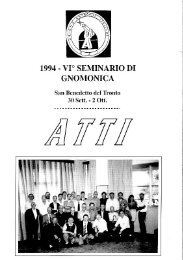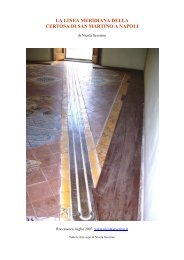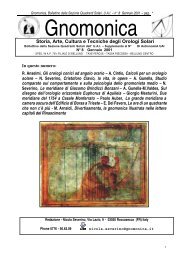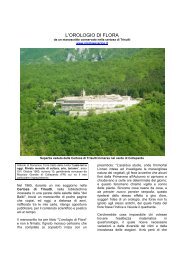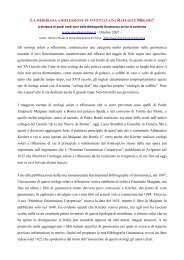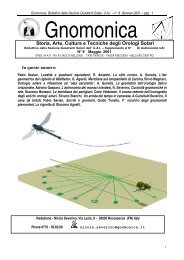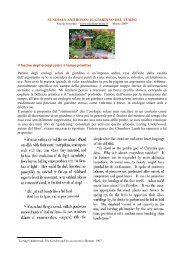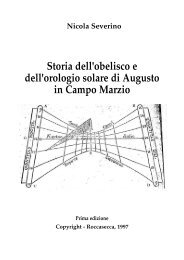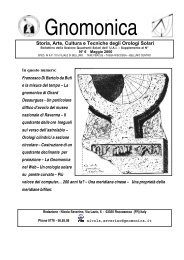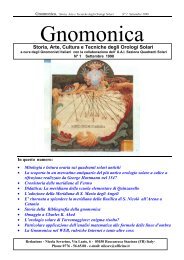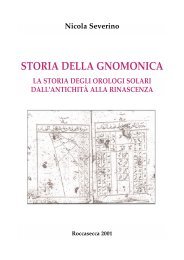le ore di norimberga svelate! - Gnomonica by Nicola Severino
le ore di norimberga svelate! - Gnomonica by Nicola Severino
le ore di norimberga svelate! - Gnomonica by Nicola Severino
You also want an ePaper? Increase the reach of your titles
YUMPU automatically turns print PDFs into web optimized ePapers that Google loves.
Il più antico orologio ad <strong>ore</strong> <strong>di</strong> Norimberga<br />
Il più antico e forse importante orologio mura<strong>le</strong> ad <strong>ore</strong> <strong>di</strong> Norimberga è quello già citato della<br />
chiesa <strong>di</strong> San L<strong>ore</strong>nzo a Norimberga. Fer de Vries mi ha inviato una prima immagine <strong>di</strong> questo<br />
orologio con il commento <strong>di</strong> cui abbiamo detto sopra. Lo stesso viene riportato, ma con un <strong>di</strong>segno<br />
non molto chiaro, dal sito <strong>di</strong> Gudrun Wolfschmidt con una breve presentazione da cui si ricava che<br />
l’orologio fu realizzato da Johannes Werner in collaborazione con Johannes Stabius nel 1502:<br />
Johannes Werner (1468-1522) stu<strong>di</strong>ed in Ingolstadt in 1484 and in Rome in 1493-97. Then he was<br />
a pastor and mathematician in his home town, Nuremberg. He improved the cross staff. In 1502<br />
Werner - in collaboration with Johannes Stabius from Austria - constructed the large sun<strong>di</strong>al at the<br />
eastern choir of the L<strong>ore</strong>nz church in Nuremberg.<br />
Fig. 7 http://www.math.uni-hamburg.de/spag/ign/xyz/ca00-v5.htm<br />
Sun<strong>di</strong>al at the eastern choir of the L<strong>ore</strong>nz church in Nuremberg, 1502 horizontal: curves of the<br />
duration of the day; vertical: lines for the normal hours; short lines: Nuremberg unequal hours.<br />
(Zinner 1956, p. 70.)<br />
Secondo quanto riportato da Gudrun, <strong>le</strong> <strong>ore</strong> <strong>di</strong> Norimberga furono utilizzate sui quadranti solari fino<br />
all’inizio del XIX secolo e valide anche in Regensburg, Schwabach, Windsheim, Rothenburg. Dalla<br />
<strong>di</strong>dascalia della figura, appren<strong>di</strong>amo anche quanto <strong>di</strong>ce Ernst Zinner in proposito, cioè che<br />
nell’orologio della chiesa <strong>di</strong> S. L<strong>ore</strong>nzo, <strong>le</strong> linee curve orizzontali rappresentano la durata del giorno<br />
(qui non si specifica che è relativa ai giorni con u numero <strong>di</strong> <strong>ore</strong> intere); <strong>le</strong> linee verticali <strong>le</strong> <strong>ore</strong><br />
astronomiche normali e <strong>le</strong> picco<strong>le</strong> linee <strong>le</strong> <strong>ore</strong> ineguali <strong>di</strong> Norimberga. Qui per “ineguali” si vuo<strong>le</strong><br />
intendere che esse hanno durata variabi<strong>le</strong> a seconda della stagione, in quanto in inverno la durata<br />
del giorno va<strong>le</strong> 8 <strong>ore</strong> e in estate 16 <strong>ore</strong>, ma sono <strong>ore</strong> uguali nell’arco <strong>di</strong> una giornata qualsiasi. La<br />
particolarità del<strong>le</strong> <strong>ore</strong> <strong>di</strong> Norimberga deriva certamente dal fatto che in quel luogo la durata del<br />
giorno al solstizio d’inverno e al solstizio d’estate è pari ad una quantità intera <strong>di</strong> <strong>ore</strong> per cui<br />
sommando o sottraendo <strong>le</strong> stesse è sempre possibi<strong>le</strong> avere la durata del giorno chiaro o della notte.<br />
Ciò è testimoniato anche dal Computus Astronomicus <strong>di</strong> Schon da cui estraggo il seguente<br />
interessante brano latino tradotto dalla dott.ssa Marisa Addomine:



